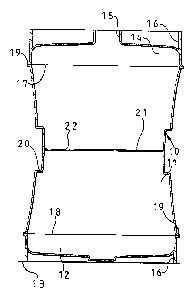Some of the information on this Web page has been provided by external sources. The Government of Canada is not responsible for the accuracy, reliability or currency of the information supplied by external sources. Users wishing to rely upon this information should consult directly with the source of the information. Content provided by external sources is not subject to official languages, privacy and accessibility requirements.
Any discrepancies in the text and image of the Claims and Abstract are due to differing posting times. Text of the Claims and Abstract are posted:
| (12) Patent: | (11) CA 2189324 |
|---|---|
| (54) English Title: | CONTAINER FOR PRESSURIZED FLUIDS |
| (54) French Title: | RECIPIENT POUR FLUIDES SOUS PRESSION |
| Status: | Term Expired - Post Grant Beyond Limit |
| (51) International Patent Classification (IPC): |
|
|---|---|
| (72) Inventors : |
|
| (73) Owners : |
|
| (71) Applicants : |
|
| (74) Agent: | MARKS & CLERK |
| (74) Associate agent: | |
| (45) Issued: | 2005-09-20 |
| (86) PCT Filing Date: | 1995-04-20 |
| (87) Open to Public Inspection: | 1995-11-16 |
| Examination requested: | 2002-04-15 |
| Availability of licence: | N/A |
| Dedicated to the Public: | N/A |
| (25) Language of filing: | English |
| Patent Cooperation Treaty (PCT): | Yes |
|---|---|
| (86) PCT Filing Number: | PCT/GB1995/000890 |
| (87) International Publication Number: | GB1995000890 |
| (85) National Entry: | 1996-10-31 |
| (30) Application Priority Data: | ||||||
|---|---|---|---|---|---|---|
|
A keg for a pressurized fluid is formed of a main body
part to respective open ends of which are secured upper and
lower ends parts each of the three parts being an injection
moulding of thermoplastics material and connected together by
welding. Around an internal surface of the main body part is
an integral continuous planar flange which serves to resist
outwards pressure on the body when the keg is pressurized, in
use, the flange defining a large central opening in the
interior of the keg. Ribs are formed integrally with the
internal body surface and flange, and extend around the
flange between respective pairs of first openings through the
flange, smaller second openings being aligned with, and
disposed at the inner end of the respective ribs.
Un fût (10), destiné à contenir un fluide sous pression, est constitué d'un corps principal (11) aux extrémités ouvertes duquel sont fixées des pièces d'extrémités supérieure et inférieure (14, 12), toutes ces parties étant moulées par injection d'un matériau thermoplastique et raccordées par soudage. Autour de la surface interne du corps principal (11), on trouve une collerette intégrée (21), continue et plane, qui permet à ce corps de résister à la pression extérieure quand le fût est mis sous pression pendant son utilisation, cette collerette définissant une grande ouverture centrale (22) à l'intérieur du fût. Des nervures (25), intégrées dans la surface interne du corps et dans la collerette, partent de chaque côté de cette collerette entre des paires respectives de premières ouvertures (23) traversant ladite collerette, des deuxièmes ouvertures (24), plus petites, étant alignées sur l'extrémité interne de leurs nervures respectives où elles sont disposées.
Note: Claims are shown in the official language in which they were submitted.
Note: Descriptions are shown in the official language in which they were submitted.

2024-08-01:As part of the Next Generation Patents (NGP) transition, the Canadian Patents Database (CPD) now contains a more detailed Event History, which replicates the Event Log of our new back-office solution.
Please note that "Inactive:" events refers to events no longer in use in our new back-office solution.
For a clearer understanding of the status of the application/patent presented on this page, the site Disclaimer , as well as the definitions for Patent , Event History , Maintenance Fee and Payment History should be consulted.
| Description | Date |
|---|---|
| Inactive: Expired (new Act pat) | 2015-04-20 |
| Grant by Issuance | 2005-09-20 |
| Inactive: Cover page published | 2005-09-19 |
| Inactive: Final fee received | 2005-07-07 |
| Pre-grant | 2005-07-07 |
| Notice of Allowance is Issued | 2005-05-25 |
| Letter Sent | 2005-05-25 |
| Notice of Allowance is Issued | 2005-05-25 |
| Inactive: Approved for allowance (AFA) | 2005-04-21 |
| Amendment Received - Voluntary Amendment | 2005-03-21 |
| Inactive: S.29 Rules - Examiner requisition | 2004-09-20 |
| Inactive: S.30(2) Rules - Examiner requisition | 2004-09-20 |
| Inactive: Agents merged | 2003-11-03 |
| Amendment Received - Voluntary Amendment | 2002-08-02 |
| Inactive: Application prosecuted on TS as of Log entry date | 2002-05-09 |
| Letter Sent | 2002-05-09 |
| Inactive: Status info is complete as of Log entry date | 2002-05-09 |
| All Requirements for Examination Determined Compliant | 2002-04-15 |
| Request for Examination Requirements Determined Compliant | 2002-04-15 |
| Letter Sent | 2000-05-11 |
| Deemed Abandoned - Failure to Respond to Maintenance Fee Notice | 1997-04-21 |
| Inactive: Adhoc Request Documented | 1997-04-21 |
| Application Published (Open to Public Inspection) | 1995-11-16 |
| Abandonment Date | Reason | Reinstatement Date |
|---|---|---|
| 1997-04-21 |
The last payment was received on 2005-03-18
Note : If the full payment has not been received on or before the date indicated, a further fee may be required which may be one of the following
Patent fees are adjusted on the 1st of January every year. The amounts above are the current amounts if received by December 31 of the current year.
Please refer to the CIPO
Patent Fees
web page to see all current fee amounts.
Note: Records showing the ownership history in alphabetical order.
| Current Owners on Record |
|---|
| KEG SERVICES LIMITED |
| CYPHERCO LIMITED |
| Past Owners on Record |
|---|
| CHRISTOPHER SIMON COURTENAY WHEATON |